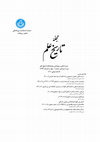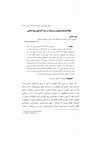Encyclopedia Entry (Persian) by Younes Karamati
دایرة المعارف بزرگ اسلامی (The Great Islamic Encyclopedia), 2018
Encyclopedia Entry (English) by Younes Karamati
Journal Article (persian) by Younes Karamati

Historical Studies of Islam
The first treatise in codex 2743 of Library of The Parliament of Iran, which cataloguers guess to... more The first treatise in codex 2743 of Library of The Parliament of Iran, which cataloguers guess to be a work of the Ḥubayš Tiflīsī, is a Persian redaction of ‘Alā’ī Maghribī’s Taqwīm al-’Adwīyah (ca. 550AH). The redactor had added some entries, numerous points, as well as a row, to mention the Indian names medicaments to the original text. He borrowed many fragments from Hājī Zayn al-‘Aṭṭār al-Šīrāzī's Iḳtiyārāt-e Badī’ī (compiled 780 AH), without any citation, and also used other sources. Therefore, and of course, due to the age of the manuscript, the possible time of the redactor's activity can be limited to the second half of the 9th to the first half of the 10th century AH. It seems that Ms. 2231 of the India Office library is another copy of this redaction. Therefore, in order to critically edit this redaction, due to the paucity and incompleteness of the manuscripts, parallel texts must be used, i.e. the original text in Arabic to edit the translated sections, the redactor’s identified resources (specially Iḳtiyārāt-e Badī’ī) to edit the scattered additions throughout the work, and the wide range of medieval Islam’s pharmacological works in which Indian name of medicaments mentioned in order to edit Indian names.

In Islamic era several remarkable works have been written about perfumes and their properties. Am... more In Islamic era several remarkable works have been written about perfumes and their properties. Among them, the similarities between the structure and content of Kitab al-Ṭīb Attributed to al-Khāzin, Mukhtaṣar fī al-Ṭīb Attributed to Ibn Kaysān and Risāla fī Uṣūl al-Ṭīb Attributed to Ibn Mandawayh are so evident that they can be considered as three versions of a single work. Usually perfumery works that have been written by physicians mention the medicinal properties of the parfumes, but the author of this work is less concerned with such properties. This fact can indicate that the author was not a physician while we know that Ibn Mandawayh and Ibn Kaysān were both physicians. Moreover, according to the introduction to the treatise, the author’s purpose is to prepare a work that would be useful for kings’ treasuries. This presumes that al-Khāzin who according to his title was a treasurer, could be the right author. In addition, comparison of scribal variants of these three versions of the treatise shows that they have a common origin. Based on some codicological evidence, all the three versions are copied from a manuscript that was written by al-Khāzin; if so, the attribution of the treatise to the others has wrongly been done by scribes.

مجله تاریخ علم (The Iranian Journal for the History of Science), 2018
ابوروح محمّد بن منصور جرجانی مشهور به زرّیندست در 480ق کتاب نورالعیون را در چشمپزشکی برای افراد... more ابوروح محمّد بن منصور جرجانی مشهور به زرّیندست در 480ق کتاب نورالعیون را در چشمپزشکی برای افراد غیرمتخصص و نیز افرادی که قصد دارند مقدمات پزشکی را فراگیرند اما عربی نمیدانند به فارسی و به شیوۀ پرسش و پاسخ نوشت. مقایسۀ این اثر با مهمترین آثار چشمپزشکی پیش از آن حاکی است که زریندست، اساس کار خود را کتاب تذکرة الکحالین علی بن عیسی کحال قرار داده و با اعمال تغییراتی چشمگیر در ساختار کلان و خرد این اثر، و افزودن مطالبی از دو منبع مهم علی بن عیسی، یعنی کتاب العشر مقالات فی العین و کتاب دوم الحاوی فی الطب و احتمالاً منابعی دیگر و نیز تجربیات خود (به ویژه در عرصۀ جراحی) اثری نو پدید آورده است.
Abū Rūḥ Mūḥammad ibn Manṣūr Jurjānī, known as Zarrīn Dast (golden handed) wrote his Nūr al-ʿUyūn in 1087 AD/480 AH for the non-specialist and those interested in the elements of medicine without knowing Arabic. A comparison of this book with the most importants texts on ophtalmogy written before it shows that the author has based his work on Tadhkira al-Kaḥḥālīn by ʿAlī ibn ʿĪsā, introducing some important changes in the general plan as well as details of Ibn ʿĪsā’s book, and adding some material form ʿAlī ibn ʿĪsā’s main sources, i.e., The Book of the Ten Treatises on the Eye by Ḥunayn ibn Isḥāq and the second Book of Razi’s Continens. Some parts of the book are based upon the author’s personal clinical observations. In this way he has creatd a new work, especially in the field of ocular surgery.

مجله تاریخ علم (The Iranian Journal for the History of Science), 2008
بررسی رسالۀ آثار علوی ابوحاتم اسفزاری (د. ح. 506-513 ق)، حاکی از آن است که وی به برخی دیدگاههای ... more بررسی رسالۀ آثار علوی ابوحاتم اسفزاری (د. ح. 506-513 ق)، حاکی از آن است که وی به برخی دیدگاههای ارسطو (384-322 ق.م) اشاره میکند که در روایت عربی آثار علوی وی دیده نمیشود؛ زیرا ابنبطریق، «پدیدآورندۀ روایت عربی» این اثر، برخی جاهای این کتاب را ترجمه نکرده و در ترجمۀ برخی جاهای دیگر نیز خطاهایی شگرف مرتکب شده است. اسفزاری، همچنین به نکاتی اشاره میکند که در هیچ یک از دو روایت یونانی و عربی نیامده است. از این رو به نظر میرسد که اسفزاری افزون بر بهرهگیری از این ترجمۀ مخدوش، به منابع دیگری، که به نحوی با روایت اصلی کتاب ارسطو مرتبط بودهاند، و دیگر مؤلفان آثار مشابه در دورۀ اسلامی، چندان با آنها آشنا نبودهاند، دسترسی داشته است. احتمالاً یکی از این منابع، رسالۀ الآثار المخیلة فی الجو الحادثة عن البخار المائی ابنخمّار (زادۀ 331ق) بوده است. آثاری که بعدها دانشمندان ایرانی در این باره نوشتند، به نحوی چشمگیر از آثار علوی اسفزاری تأثیر پذیرفته است.
There are references to Aristotle’s view points about meteorology in Asfizari’s treatise entitled Athar-i ulwi that have not been existed in the Arabic translation of Aristotle’s Meteorologica. Ibn Bitr?k, the Arabic translator, did not translate some parts of the book and there are mistakes in his translation. Asfizari has also mentioned some points which cannot be found in the original work of Aristotle; so one could say that Asfizari in addition to this Arabic translation, had access to some other sources connected to Aristotle’s original work. It seems that other composers of metrological works were not familiar with these sources which Al-Athar al-Mukhayyala fi al-Djaww al-Haditha an al-Bukhar al-Ma' of Ibn Khammar is probably one of them. Later meteorological works are considerably affected by Asfizari’s Athar-i Ulwi
Journal Article (English) by Younes Karamati
Journal for the History of Science, 2021
Kitāb al-Ṭīb (The Book of Aromatics) composed by al-Khāzin (living in 421 A.H./1030 A.D.), is an ... more Kitāb al-Ṭīb (The Book of Aromatics) composed by al-Khāzin (living in 421 A.H./1030 A.D.), is an Arabic treatise written in the fourth/tenth century containing a prologue and five chapters dealing with Simple Aromatic Substances (musk, amber, aloeswood, camphor) and including 23 recipes for making compound aromatics (al-Nadd, alʿŪd al-Muṭarrā, al-Lakhlakha, al-Ghālīya, al-Dharīra, al-Rāmik, al-Sukk and, Duhn Al-Bān). This article tries to prepare a critical edition of Kitāb al-Ṭīb based on the extant copies and considering the parallel texts. In addition to the edited text, the article contains the translation of the prologue to the treatise and a discussion about the title and author of it, while trying to shed light on the toponyms and ethnonyms used for the appellation of simple aromatics of different types.
The treatise called "Kitāb al-Ṭīb" is a work composed by Muḥammad b. al-Ḥasan b. Ibrāhīm al-Khāzi... more The treatise called "Kitāb al-Ṭīb" is a work composed by Muḥammad b. al-Ḥasan b. Ibrāhīm al-Khāzin (living in 421/1030), dealing with aromatic substances. There are four known copies of this work, the oldest one (Princeton, Garrett, 174B) dated 590/1194 is incomplete and disorderly in its present situation. Rearranging this manuscript and clarifying the relationship between all extant manuscripts of the work seem necessary for a critical edition of it. Based on the repetition of a note referring to the contents and order of treatises in three codices, similarities in the colophon of them, different readings of same words in each of these manuscripts, as well as the text conflations, the most probable explanation is that the Princeton manuscript has been the basis of copying the other three manuscripts.
Papers by Younes Karamati
Journal for the History of Science
Kitāb al-Ṭīb (The Book of Aromatics) composed by al-Khāzin (living in 421 A.H./1030 A.D.), is an ... more Kitāb al-Ṭīb (The Book of Aromatics) composed by al-Khāzin (living in 421 A.H./1030 A.D.), is an Arabic treatise written in the fourth/tenth century containing a prologue and five chapters dealing with Simple Aromatic Substances (musk, amber, aloeswood, camphor) and including 23 recipes for making compound aromatics (al-Nadd, alʿŪd al-Muṭarrā, al-Lakhlakha, al-Ghālīya, al-Dharīra, al-Rāmik, al-Sukk and, Duhn Al-Bān). This article tries to prepare a critical edition of Kitāb al-Ṭīb based on the extant copies and considering the parallel texts. In addition to the edited text, the article contains the translation of the prologue to the treatise and a discussion about the title and author of it, while trying to shed light on the toponyms and ethnonyms used for the appellation of simple aromatics of different types.
Journal for the History of Science
Persian Redaction of Biruni's Al-Saydanah and Its Composer










Uploads
Encyclopedia Entry (Persian) by Younes Karamati
Encyclopedia Entry (English) by Younes Karamati
Journal Article (persian) by Younes Karamati
Abū Rūḥ Mūḥammad ibn Manṣūr Jurjānī, known as Zarrīn Dast (golden handed) wrote his Nūr al-ʿUyūn in 1087 AD/480 AH for the non-specialist and those interested in the elements of medicine without knowing Arabic. A comparison of this book with the most importants texts on ophtalmogy written before it shows that the author has based his work on Tadhkira al-Kaḥḥālīn by ʿAlī ibn ʿĪsā, introducing some important changes in the general plan as well as details of Ibn ʿĪsā’s book, and adding some material form ʿAlī ibn ʿĪsā’s main sources, i.e., The Book of the Ten Treatises on the Eye by Ḥunayn ibn Isḥāq and the second Book of Razi’s Continens. Some parts of the book are based upon the author’s personal clinical observations. In this way he has creatd a new work, especially in the field of ocular surgery.
There are references to Aristotle’s view points about meteorology in Asfizari’s treatise entitled Athar-i ulwi that have not been existed in the Arabic translation of Aristotle’s Meteorologica. Ibn Bitr?k, the Arabic translator, did not translate some parts of the book and there are mistakes in his translation. Asfizari has also mentioned some points which cannot be found in the original work of Aristotle; so one could say that Asfizari in addition to this Arabic translation, had access to some other sources connected to Aristotle’s original work. It seems that other composers of metrological works were not familiar with these sources which Al-Athar al-Mukhayyala fi al-Djaww al-Haditha an al-Bukhar al-Ma' of Ibn Khammar is probably one of them. Later meteorological works are considerably affected by Asfizari’s Athar-i Ulwi
Journal Article (English) by Younes Karamati
Papers by Younes Karamati
Abū Rūḥ Mūḥammad ibn Manṣūr Jurjānī, known as Zarrīn Dast (golden handed) wrote his Nūr al-ʿUyūn in 1087 AD/480 AH for the non-specialist and those interested in the elements of medicine without knowing Arabic. A comparison of this book with the most importants texts on ophtalmogy written before it shows that the author has based his work on Tadhkira al-Kaḥḥālīn by ʿAlī ibn ʿĪsā, introducing some important changes in the general plan as well as details of Ibn ʿĪsā’s book, and adding some material form ʿAlī ibn ʿĪsā’s main sources, i.e., The Book of the Ten Treatises on the Eye by Ḥunayn ibn Isḥāq and the second Book of Razi’s Continens. Some parts of the book are based upon the author’s personal clinical observations. In this way he has creatd a new work, especially in the field of ocular surgery.
There are references to Aristotle’s view points about meteorology in Asfizari’s treatise entitled Athar-i ulwi that have not been existed in the Arabic translation of Aristotle’s Meteorologica. Ibn Bitr?k, the Arabic translator, did not translate some parts of the book and there are mistakes in his translation. Asfizari has also mentioned some points which cannot be found in the original work of Aristotle; so one could say that Asfizari in addition to this Arabic translation, had access to some other sources connected to Aristotle’s original work. It seems that other composers of metrological works were not familiar with these sources which Al-Athar al-Mukhayyala fi al-Djaww al-Haditha an al-Bukhar al-Ma' of Ibn Khammar is probably one of them. Later meteorological works are considerably affected by Asfizari’s Athar-i Ulwi